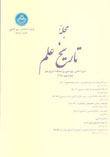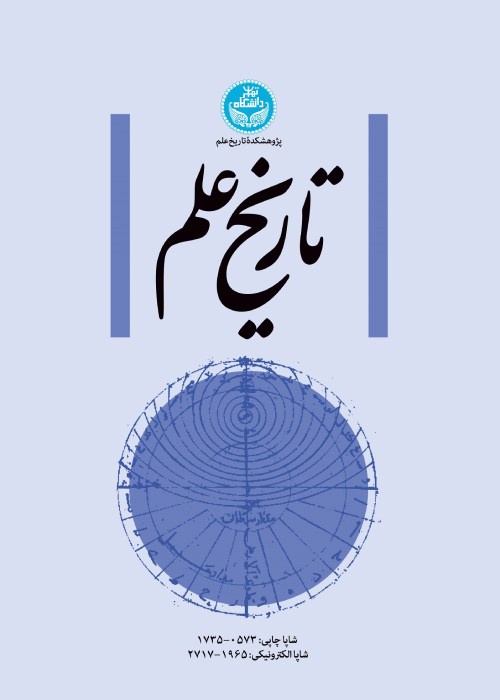فهرست مطالب

مجله تاریخ علم
سال دهم شماره 2 (پیاپی 13، پاییز و زمستان 1391)
- تاریخ انتشار: 1391/09/27
- تعداد عناوین: 6
-
-
صفحات 1-15در طب اسلامی شش امر را در سلامتی هر کس موثر دانسته اند و پزشکان برای حفظ و بازگرداندن سلامتی به بدن انسان می کوشند تا این امور را متعادل نگاه دارند. پزشکان تمدن اسلامی، همواره ورزش را یکی از مهم ترین این امور، هم برای حفظ تندرستی و هم برای درمان، دانسته اند. این مقاله در پی آن است که دیدگاه های گروهی از پزشکان مسلمان را درباره مسائل مربوط به ورزش، مانند جایگاه و تعریف آن در طب اسلامی، ضرورت و زمان مناسب برای پرداختن به آن، توصیه های ورزشی پزشکان برای افراد مختلف و جز آن، بررسی کند.
کلیدواژگان: پزشکان تمدن اسلامی، سته ضروریه، ورزش -
صفحات 17-34غافقی (سده 6ق) گیاه شناس اندلسی است و مهم ترین اثر او الجامع فی الادویه المفرده، یکی از اصلی ترین پایه های دانش گیاه شناسی در اندلس و از منابع مهم برای حفظ و احیای میراث گذشته این دانش است. این کتاب از آثار گیاه شناسی پیش از خود، به ویژه النبات دینوری و قانون ابن سینا، تاثیر بسیاری گرفته است. در این مقاله ابتدا مشهورترین نسخه های این کتاب معرفی شده است، سپس بر اساس نسخه کتابخانه ملک با بررسی ارجاعات متنوع و دقیق آن از متون پیشین و برخی آثار هم دوره اش، جایگاه برجسته این کتاب در حفظ میراث گذشته، مشخص شده است. سپس بر اساس دانش گیاه شناسی امروزی متن کتاب را بررسی کرده ایم. روش غافقی در دانش گیاه شناسی، مشاهده تجربی، ثبت دقیق این اطلاعات و مقایسه میان آنهاست. بر اساس این روش، طبقات، زیست گاه ها و جغرافیای گیاهی و ریخت شناسی گیاهان مشخص شده اند. بررسی مترادف نام گیاهان در زبان های اندلسی، بربری، یونانی، سریانی و حتی فارسی و ادویه حیوانی و معدنی از نکات برجسته دیگر این کتاب است.
کلیدواژگان: اکولوژی گیاهی، جامع غافقی، ریخت شناسی گیاهی، طبقه بندی گیاهی، گیاه شناسی -
صفحات 35-63مخروطات یا همان دانش مطالعه مقاطع مخروطی از عالی ترین مباحث نظری هندسه دوران باستان و سده های میانه بوده که به خاطر کاربردهای عملی نیز مورد توجه قرار می گرفته است. در پژوهش پیش رو، پس از اشاره ای کوتاه به تاریخچه مخروطات در یونان و در تمدن اسلامی، چگونگی راه یابی آن به کتاب های درسی دوره قاجار و کمی پس از آن در ایران، و نیز دگرگونی واژگان این علم در جریان این انتقال، بررسی می شود.
کلیدواژگان: ایران معاصر، دارالفنون، کرشیش، مخروطات، مهندس الملک -
صفحات 65-91ابوالوفا بوزجانی از ریاضی دانان تراز اول دوره اسلامی است که کتاب او درباره اعمال هندسی زمینه ساز مباحث و تحقیقات بسیاری در حوزه های تاریخ علم، معماری و صناعات وابسته بوده است. با وجود این، تاکنون سهم واقعی او در صناعات معماری در سایه جایگاه علمی او پنهان و ناشناخته مانده است. هدف این مقاله روشن ساختن میراث ابوالوفا در ریاضیات معماری میان اصحاب و دست اندرکاران معماری با تکیه بر روش تحلیل (شباهت های ساختاری) تاریخی است. برای این پس از نیم نگاهی به زمینه های تکوین آثار حساب و هندسه عملی او در سده 4ق/10م، روش های هندسی ابوالوفا و میزان عملی بودن آنها را با روش های معماران و صنعتگران در کنار یکدیگر بررسی تطبیقی کرده ایم. یافته های پژوهش حاضر نشان می دهند که هرچند ابوالوفا در کتاب اعمال هندسی مبانی هندسه عملی - به ویژه در هندسه مسطحه - را گردآوری، تدقیق کرده و راه حل های مختلفی را برای مسائل عرضه کرده است، اما روش های او نقش چندانی در طراحی هندسی اصحاب معماری نداشته است. زیرا اصحاب صناعات بخش قابل توجهی از مسائل این کتاب را به دلیل وجود روش های ساده تر و عملی تر به کار نبرده اند. چنین می نماید که میراث اصلی ابوالوفا در معماری، علم حساب ابنیه است، که او مقدمات حساب عملی را برای دبیران، محاسبان و ناظران مالیه ساختمانی تدوین نمود.
کلیدواژگان: ابوالوفا بوزجانی، اعمال هندسی، حساب، صنعتگران، معماری -
صفحات 93-126وبا و طاعون از جمله همه گیر های مهلک و ویرانگری بود که بارها در سده های سیزدهم و چهاردهم قمری در نقاط مختلف ایران ظهور کرد و تلفات و خسارات فراوانی از خود به جای گذاشت. تقریبا از سده چهاردهم بدین سو بود که با رواج اصول و قواعد بهداشتی جدید، گسترش بهداشت عمومی و اقداماتی برای جلوگیری از ورود و سرایت این امراض، رفته رفته ظهور آنها در ایران متوقف شد. موضوع اصلی در این نوشته، بررسی واکنش طبابت بومی ما در بدو ورود این امراض به ایران سده سیزدهم قمری است. مساله این است که طبابت بومی ما به مثابه دانشی که به وقت هجوم این امراض، انتظار پاسخگویی از آن می رفت، ماهیت این امراض را چگونه تشخیص می داده، چه مشخصه هایی برای آنها در نظر می گرفته و نهایتا چه معالجاتی را توصیه می کرده است. در نهایت، به پاره ای اختلاف نظرات درباره چیستی و تشخیص و علاج این امراض در میان سایر اطبا اشاره خواهد شد.
کلیدواژگان: تاریخ پزشکی، طاعون، طب سنتی، وبا -
صفحه 127قطب الدین شیرازی علاوه بر آثار مشروحی که هیئت و فلسفه نوشته است اثر مشروحی نیز در پزشکی دارد: ابتحفه السعدیه که شرحی بر مقاله اول قانون ابن سینا است و در نه مجلد نوشته شده است. این مطلب چندان دور از انتظار نیست زیرا قطب الدین از خانواده ای که سابقه طبابت داشته اند برآمده است و در سال های جوانی عمر خود قانون را مطالعه کرده بود. این شرح مطول اطلاعات جامعی درباره آثار مختلف پزشکی دیگری که قطب الدین از آنها استفاده می کرده است به ما می دهد. در این مقاله، من برآنم تا چگونگی استفاده از آثار دیگر را در تدوین این کتاب بزرگ روشن کنم. به ویژه بر موضوع استفاده قطب الدین از اثر پزشکی ابن رشد در التحفه السعدیه و اهمیت ابن رشد نزد دانشمندان سرزمین های شرقی خلافت اسلامی تاکید خواهم کرد.
کلیدواژگان: کتاب الکلیات، قطب الدین شیرازی، القانون فی الطب، ابن رشد، التحفه السعدیه
-
Pages 1-15In Islamic medicine six factors are thought to affect the health of every person and physicians try to maintain and restore health by establishing an equilibrium between them. Sport has always been considered as one the most important among these factors, both for its role in mainting health and treating the diseases. The aim of this paper is to discuss the views of certain Islamic physicians on subjects pertaining to sport. These include the definition of sport, its place in Islamic medicine, its necessity and the convenient time to practice it, as well as the sports prescribed for different groups of people.Keywords: Islamic physicians, “the six necessary causes”, sports
-
Pages 17-34Ghāfiqī (6th/12th century) is an Andalusian botanist whose al-Jāmiʿ fī al-Adwiya al-Mufrada is one of the principal pillars of the science of botany in Andalusia and one of the most important sources for knowing and reconstructing the past history of this science. This book ows much to earlier botanical works, especially al-Nabāt of Dīnawarī and al-Qānūn of Ibn Sīnā. In this paper, first the most famous manuscripts of this book introduce are introduced. Then on the basis of the Malik manuscript the things cited by Ghāfiqī from earlier and contemporary works are discussed, and thus the eminent role of this book in preserving the past heritage is underlined. Then the book is analysed on the basis of modern botanical science. Ghāfiqī’s method in botany consists of empirical observation, exact recording of these data and comparing them with each other. By this method, classes, babitats, plant geography and morphology of plants are characterized. Mentioning the names of the plants in Andalusian, Barbar, Greek, Syriac and even Persian is another salient point of this book.Keywords: Botany, Ecology, Jāmiʿ morphology, taxonomy
-
Pages 35-63Conics or the science of conic sections is one of the highest theoretical topics of geometry in Classical Antiquity and the Middle Ages. It was also studied for its practical applications. In this paper, we first present a short history of conics in Antiquity and the Islamic civilization, then we show how this discipline was introduced in Persian textbooks in the Qajar period and a little after, and how, through this transmission, its vocabulary underwent a change.Keywords: Contemporary Iran, Dār al Funūn, Kříž Conics, Muhandis al Mulk
-
Pages 65-91Abū al-Wafā Būzjānī is one of the top mathematicians in Islamic period. His book on geometrical constructions has been the subject of many discussions and researchers in the fields of history of science, architecture and related crafts. Nevertheless, despite these researchers, its exact contribution to art and architecture has not been identified. The main purpose of this article is to clarify Abū al-Wafā’s heritage in the mathematics of architecture by relying on the historical analysis method (structural similarities). In this paper, after an overview of the formation of practical arithmetic and geometry during century 4 AH/10 AD, Abū al-wafā’s geometric methods and their practicality are compared with artisans and architects’ methods. The findings of the present research reveals that although Abū al-Wafā collected the basic rules of the use of geometry, and especially that of plane geometry, and presented different solutions for problems, his methods did little contribute to geometric designs of artisans and architects. Due to their simpler and more practical methods, the artisans and architects did not use a considerable portion of Būzjānī’s book. It seems that the main heritage of Abū al-Wafā in architecture is his discussion of the arithmetic of buildings. He formulated the preliminaries of practical arithmetic for secretaries, accountants, and financial overseers of buildings.Keywords: Architecture, Arithmetic, Artisans, Abū al Wafā Būzjānī Geometry
-
Iranian Medicine's Encounter with the Cholera and Plague Epidemics in Qajar Iran in the 19th CenturyPages 93-126Cholera and plague were widespread deadly epidemics and diseases which broke out in the some regions of Iran for several times during the 19th and 20th centuries. Since the early 20th century, the spreading of these diseases ceased due to the introduction of modern sanitary rules and principles, development of public health and the use of some preventive measures. This article discusses the Iranian medicine’s reaction to the cholera and plague outbreaks in the 19th century. The main concern is how the discourse of the Iranian medicine dealt with the problem of cholera and plague when these diseases emerged. The subject is how this kind of knowledge diagnosed these diseases, what nature it assumed for them and what treatments prescribed. This study focuses on the first decades of the emerging of those epidemics before the encounter of Iranian medicine with modern western medicine.Keywords: Cholera, History of medicine, Iranian medicine, Plague
-
Page 127Quṭb al-Dīn Shīrāzī wrote several huge works not only on mathematical sciences and philosophy, but also on medicine: a commentary on volume 1 of Ibn Sīnā’s al-Qānūn fī al-Ṭibb entitled al-Tuḥfa al-Saʿdīya in nine volumes. This is not surprising because Quṭb al-Dīn came from a family of physicians and he received medical education in his youth by reading Ibn Sīnā’s Qānūn. This enormous commentary ought to give us comprehensive information about books on medicine and its allied disciplines available to Quṭb al-Dīn. In this article, I will elucidate how he utilized these books when composing such a huge work. Particularly, I will focus on how Quṭb al-Dīn used Ibn Rushd’s medical work in his al-Tuḥfa al-Saʿdīya, and rethink the importance of Ibn Rushd in the East.Keywords: Kitāb al Kullīyyāt, Quṭb al Dīn Shīrāzī al Qānūn fī al Ṭibb, Ibn Rushd, al, Tuḥfa al Saʿdīya


